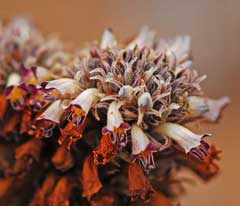 |
|
Jamee Moulton, some rights reserved (CC-BY-NC) |
 |
| www.flickr.com/photos/jroldenettel |
Translate this page:
Summary
Physical Characteristics

 Orobanche ludoviciana is a PERENNIAL growing to 1.5 m (5ft). The species is hermaphrodite (has both male and female organs).
Orobanche ludoviciana is a PERENNIAL growing to 1.5 m (5ft). The species is hermaphrodite (has both male and female organs).
Suitable for: light (sandy), medium (loamy) and heavy (clay) soils and prefers well-drained soil. Suitable pH: mildly acid, neutral and basic (mildly alkaline) soils. It can grow in full shade (deep woodland) semi-shade (light woodland) or no shade. It prefers moist soil.
UK Hardiness Map
US Hardiness Map
Synonyms
Homotypic Synonyms: Aphyllon ludovicianum (Nutt.) A.Gray. Conopholis ludoviciana (Nutt.) A.Wood. Myzorrhiza ludoviciana (Nutt.) Rydb. O. ludoviciana var. genuina Beck. Phelypaea ludoviciana (Nutt.) G.Don.
Plant Habitats
Woodland Garden Dappled Shade; Shady Edge; not Deep Shade;
Edible Uses
Edible Parts: Root Stem
Edible Uses:
Root - roasted[46, 61, 105, 161]. Stem[46, 61, 105]. Base of young stems roasted[257].
References More on Edible Uses
Medicinal Uses
Plants For A Future can not take any responsibility for any adverse effects from the use of plants. Always seek advice from a professional before using a plant medicinally.
The chewed plant has been used as a dressing on wounds[257]. A poultice of the stems has been used in the treatment of ulcerated sores[257].
References More on Medicinal Uses
The Bookshop: Edible Plant Books
Our Latest books on Perennial Plants For Food Forests and Permaculture Gardens in paperback or digital formats.

Edible Tropical Plants
Food Forest Plants for Hotter Conditions: 250+ Plants For Tropical Food Forests & Permaculture Gardens.
More

Edible Temperate Plants
Plants for Your Food Forest: 500 Plants for Temperate Food Forests & Permaculture Gardens.
More

More Books
PFAF have eight books available in paperback and digital formats. Browse the shop for more information.
Shop Now
Other Uses
References More on Other Uses
Cultivation details
A fully parasitic plant lacking in chlorophyll depends entirely on its host plant to obtain nutrients [200]. Since A. ludovicianum is an obligate parasite, the conditions for its growth are entirely dependent on the host species. It is not possible to advocate a regimen for care. Note: Researchers in North America have attempted the cultivation of several species of Aphyllon with little success, including A. ludovicianum.
References Carbon Farming Information and Carbon Sequestration Information
Temperature Converter
Type a value in the Celsius field to convert the value to Fahrenheit:
Fahrenheit:
The PFAF Bookshop
Plants For A Future have a number of books available in paperback and digital form. Book titles include Edible Plants, Edible Perennials, Edible Trees,Edible Shrubs, Woodland Gardening, and Temperate Food Forest Plants. Our new book is Food Forest Plants For Hotter Conditions (Tropical and Sub-Tropical).
Shop Now
Plant Propagation
Seed - we have no information on this species but suggest sowing the seed in a greenhouse in a pot containing a host plant. The seed is probably best sown as soon as it is ripe if this is possible. It might also be possible to sow the seed in situ around a host plant.
Other Names
If available other names are mentioned here
Native Range
NORTHERN AMERICA: Canada (Saskatchewan, Alberta, Manitoba, British Columbia), United States (Indiana, Ohio, Iowa, Kansas, Minnesota, Missouri, Nebraska, North Dakota, South Dakota, Illinois, Oklahoma, Wisconsin, Colorado, Idaho, Montana, Oregon, Washington, Wyoming, Arkansas, Kentucky, Tennessee, Virginia, New Mexico, Texas, Arizona, Nevada, Utah)
Weed Potential
Right plant wrong place. We are currently updating this section.
Please note that a plant may be invasive in one area but may not in your area so it's worth checking.
All species of Aphyllon (and Orobanche) are potential or actual crop pests.
Conservation Status
IUCN Red List of Threatened Plants Status :

Growth: S = slow M = medium F = fast. Soil: L = light (sandy) M = medium H = heavy (clay). pH: A = acid N = neutral B = basic (alkaline). Shade: F = full shade S = semi-shade N = no shade. Moisture: D = dry M = Moist We = wet Wa = water.
Now available:
Food Forest Plants for Mediterranean Conditions
350+ Perennial Plants For Mediterranean and Drier Food Forests and Permaculture Gardens.
[Paperback and eBook]
This is the third in Plants For A Future's series of plant guides for food forests tailored to
specific climate zones. Following volumes on temperate and tropical ecosystems, this book focuses
on species suited to Mediterranean conditions—regions with hot, dry summers and cool, wet winters,
often facing the added challenge of climate change.
Read More
Expert comment
Author
Nutt.
Botanical References
4371235
Links / References
For a list of references used on this page please go here
Readers comment
| Add a comment |
|
If you have important information about this plant that may help other users please add a comment or link below. Only comments or links that are felt to be directly relevant to a plant will be included. If you think a comment/link or information contained on this page is inaccurate or misleading we would welcome your feedback at [email protected]. If you have questions about a plant please use the Forum on this website as we do not have the resources to answer questions ourselves.
* Please note: the comments by website users are not necessarily those held by PFAF and may give misleading or inaccurate information.
To leave a comment please Register or login here All comments need to be approved so will not appear immediately.
|
Subject : Orobanche ludoviciana
|
|
|
|